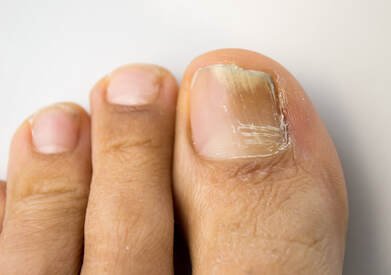Nail Fungus
Thick, Yellow Nails
 Nail fungus AKA onychomycosis, is a common condition in which fungus infects the nail bed, the nail plate or both. This type of infection is usually caused by the dermatophytes class of fungi, but can also be caused by yeasts and other molds. Nail fungus causes discolouration (yellow, brown or white), thickening, and lifting of the nail from the nail bed. The nail can also become brittle with ragged edges. This can lead to an unsightly appearance and discomfort.
Nail fungus AKA onychomycosis, is a common condition in which fungus infects the nail bed, the nail plate or both. This type of infection is usually caused by the dermatophytes class of fungi, but can also be caused by yeasts and other molds. Nail fungus causes discolouration (yellow, brown or white), thickening, and lifting of the nail from the nail bed. The nail can also become brittle with ragged edges. This can lead to an unsightly appearance and discomfort.
Nail fungus is very common, affecting approximately 10% of the general population worldwide. This rate doubles to 20% in individuals over 60 years of age.
Risk Factors
- Those with a history of athlete’s foot
- Individuals with compromised immune systems
- Those who have diabetes
- Individuals who frequently expose their feet to moist environments, such as swimmers and athletes.
- Those who wear sweaty or damp socks all day
- Trauma – If the nail is lifted or dislodged, it’s natural defense against fungus is limted
- Tight fitting footwear can help “drive” fungus under the nail
- Sharing contaminated nail clippers/files
Treatment
Different fungal nail infections exhibit distinct characteristics and respond differently to treatment protocols. Recognizing these differences allows chiropodists to tailor their approach to each specific case, thereby increasing the likelihood of successful management and resolution of the infection. It is important to note that not all nail abnormalities are due to fungal infections. Conditions such as psoriasis, eczema or trauma to the nail can mimic the symptoms of nail fungus from other disorders. Therefore, professional diagnosis is vital in distinguishing nail fungus from other nail disorders.
Early detection is crucial in managing and treating nail fungus effectively. Recognizing symptoms early on can prevent the infection from spreading to other nails or to the skin. Early detection also makes the treatment more effective. Late stage nail fungus (total dystrophic onychomycosis) is incredibly resistant to treatment.
There are various treatment options available, ranging from prescription medications to surgical removal. The choice of treatment often depends on the extent of the infection and individual patient factors.
Prescription topical antifungal treatments prescribed by a chiropodist is typically the 1st line treatment for mild to moderate cases. These topicals include medicated creams or nail lacquers that are applied directly to the nail, or nail bed. It is important to have the nail thinned (debrided) by a chiropodist regularly during treatment to allow the medication to penetarate the thickened nail.
For severe cases or cases that are resistant to topical treatments there are surgical options. The affected nail can be surgically removed, allowing better access to the underlying fungus. The fungus can then be treated directly with a topical medicine while a new clear nails grows in its place. Unfortunately, sometimes this treatment still yeilds a new nail that is infected with fungus. In this case, there is the option of permanent nail removal. In this procedure, the nail would be removed, then the “root” of the nail, known as the nail matrix, would be cauterized. After healing, the area of the previous nail would be skin instead of nail.
Alternative treatments and home remedies can also be considered. These include natural remedies like tea tree oil, vinegar soaks, and the application of Vicks VapoRub. While anecdotal evidence suggests some benefit, scientific backing for these methods is limited. Patients opting for alternative treatments should do so with caution and ideally under the guidance of a chiropodist.
The pros and cons of each treatment method must be weighed carefully and would be discussed with our chiropodist, Jake Cahoon.
Adherence to the treatment plan is crucial for successful outcomes. Nail fungus can be resilient, requiring prolonged and consistent treatment often over several months, even years.
Once the nail is successfully treated, maintaining proper foot/nail hygiene is essential in preventing reinfection. Regular foot hygeine, keeping socks dry during the day, and avoiding sharing nail clippers can significantly reduce the risk of recurrence.
